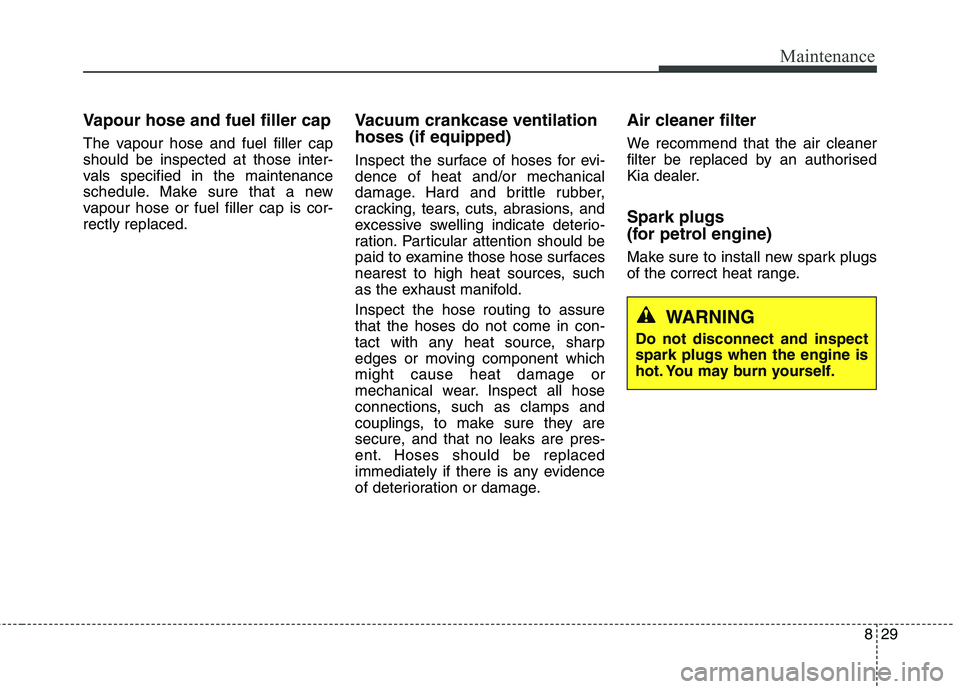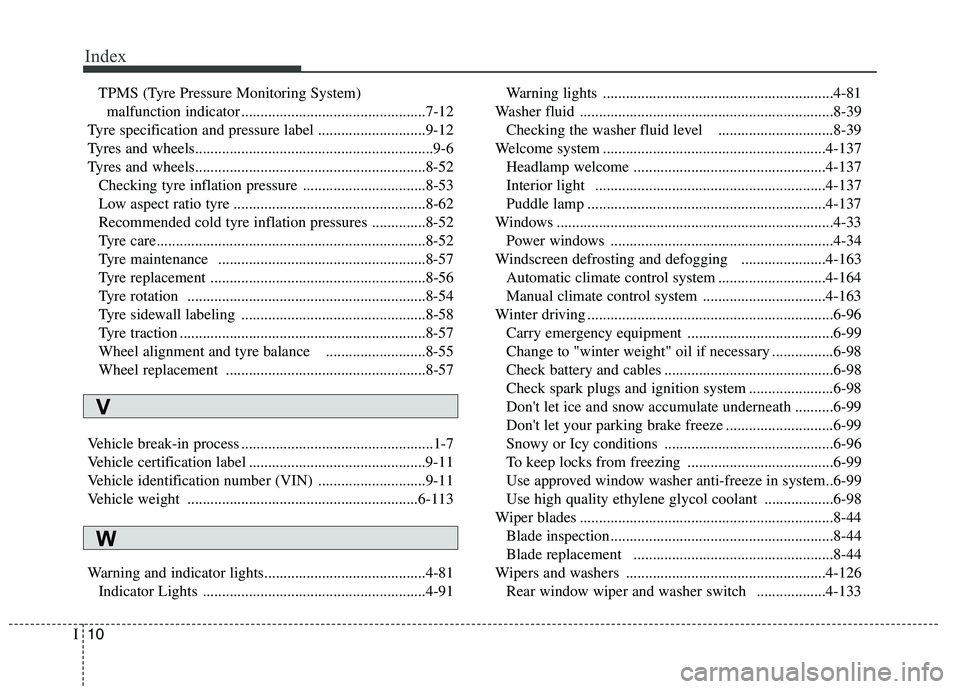2017 KIA CARENS RHD spark plugs replace
[x] Cancel search: spark plugs replacePage 533 of 723

Driving your vehicle
98
6
Use high quality ethylene gly- col coolant
Your vehicle is delivered with high
quality ethylene glycol coolant in the
cooling system. It is the only type ofcoolant that should be used because
it helps prevent corrosion in the cool-
ing system, lubricates the water
pump and prevents freezing. Be sure
to replace or replenish your coolantin accordance with the maintenance
schedule. Before winter, have yourcoolant tested to assure that its
freezing point is sufficient for the
temperatures anticipated during the
winter.
Check battery and cables
Winter puts additional burdens on
the battery system. Visually inspect
the battery and cables as described
in chapter 8. We recommend that the
system be checked by an authorised
Kia dealer. Change to "winter weight" oil
if necessary In some climates it is recommended
that a lower viscosity "winter weight"
oil be used during cold weather. See
chapter 9 for recommendations. If
you aren't sure what weight oil you
should use, we recommend that you
consult an authorised Kia dealer.
Check spark plugs and igni- tion system
Inspect your spark plugs as
described in chapter 8 and replace
them if necessary. Also check all
ignition wiring and components to be
sure they are not cracked, worn or
damaged in any way.
CAUTION
Chains that are the wrong size
or improperly installed candamage your vehicle's brakelines, suspension, body andwheels.
Stop driving and retighten the chains any time you hear themhitting the vehicle.
WARNING - Tyre chains
The use of chains may adversely affect vehicle han- dling.
Do not exceed 30 km/h (20 mph) or the chain manufactur-
er’s recommended speed
limit, whichever is lower.
Drive carefully and avoid bumps, holes, sharp turns,
and other road hazards, which
may cause the vehicle to
bounce.
Avoid sharp turns or locked- wheel braking.
Page 601 of 723

Maintenance
14
8
Normal Maintenance Schedule - For Europe (Except Russia) (Continue)
I : Inspect and if necessary, adjust, correct, clean or replace.
R : Replace or change.
MAINTENANCE
INTERVALS
MAINTENANCE ITEMNumber of months or driving distance, whichever comes first
Months24487296120144168192
Miles×1,00020406080100120140160
Km×1,000306090120150180210240
Engine oil and engine oil filter(Petrol,Diesel) * 4RRRRRRRR
Coolant (Engine) *1At first, Replace 210,000 km (140,000 miles) or 120 months
after that, Replace every 30,000 km (20,000 miles) or 24 months
Drive belts (Engine) * 2
PetrolAt first, Inspect 90,000 km (60,000 miles) or 72 months
after that, Inspect every 30,000 km (20,000 miles) or 24months
DieselAt first, Inspect 90,000 km (60,000 miles) or 48months
after that, Inspect every 30,000 km (20,000 miles) or 24months
Valve clearance (Except for Nu 2.0 Engine) * 8--I--I--
Spark plugs (Petrol - Iridium) *9Replace every 160,000 km (104,000 miles) or 120months
Automatic transaxle fluid (if equipped)No check, No service required
Manual transaxle fluid (if equipped) * 3-I-I-I-I
Dual clutch transmission fluid (if equipped) * 3-I-I-I-I
Drive shafts and bootsIIIIIIII
Fuel additives (Petrol) *6Add every 15,000 km (10,000 miles) or 12 months
Fuel filter cartridge (Diesel) * 7RRRRRRRR
Page 605 of 723

Maintenance
18
8
Severe driving conditions
A : Repeatedly driving short distance of less than 8 km (5
miles) in normal temperature or less than 16 km (10 miles)
in freezing temperature.
B : Extensive engine idling or low speed driving for long dis- tances.
C : Driving on rough, dusty, muddy, unpaved, graveled or salt- spread roads.
D : Driving in areas using salt or other corrosive materials or in very cold weather. E : Driving in heavy dust condition.
F : Driving in heavy traffic area.
G : Driving on uphill, downhill, or mountain roads repeatedly.
H : Towing a trailer or using a camper on roof rack.
I : Driving for patrol car, taxi, commercial car or vehicle towing.
J : Driving over 170 km/h (106 mile/h).
K : Frequently driving in stop-and-go conditions.
Maintenance itemMaintenance
operationMaintenance intervalsDriving Condition
Front suspension ball jointsIInspect more frequently depending on the conditionC, D, E, F, G
Disc brakes and pads, calipers and rotorsIInspect more frequently depending on the conditionC, D, E, G, H
Parking brake (Hand type)IInspect more frequently depending on the conditionC, D, G, H
Drive shaft and bootsIInspect more frequently depending on the conditionC, D, E, F,
G, H, I, J, K
Climate control air filter RReplace more frequently depending on the conditionC, E, G
Spark plugsRReplace more frequently depending on the conditionB, H, I, K
Page 610 of 723

823
Maintenance
Normal Maintenance Schedule - Except Europe (Including Russia) (Continue)
MAINTENANCE INTERVALS
MAINTENANCE ITEMNumber of months or driving distance, whichever comes first
Months1224364860728496
Miles×1,0001020304050607080
Km×1,000153045607590105120
Valve clearance(Except for Nu 2.0 Engine) * 9Inspect every 90,000 Km (60,000 miles) or 72 months
Spark plugsPetrol - Iridium *10
Replace every 160,000 km (104,000 miles) or 120months
Petrol - NickelRR
Automatic transaxle fluid (if equipped)No check, No service required
Manual transaxle fluid (if equipped) * 3II
Dual clutch transmission fluid (if equipped) * 3II
Drive shafts and bootsIIII
Fuel additives (Petrol) *6Add every 10,000 km (6,500 miles) or 6 months (For Australia and
New Zealand : Add every 15,000 km (10,000 miles) or 12 months
Fuel filter (Petrol) * 8For China, BrazilIRIR
Fuel filter cartridge (Diesel) * 7RRRR
Fuel lines, hoses and connectionsPetrolII
DieselIIII
Fuel tank air filter (if equipped)PetrolIRIR
Vapor hose and fuel filler capPetrolII
Fuel filler cap (Diesel)DieselII
I : Inspect and if necessary, adjust, correct, clean or replace. R : Replace or change.
Page 614 of 723

827
Maintenance
Severe driving conditions
A : Repeatedly driving short distance of less than 8 km (5miles) in normal temperature or less than 16 km (10 miles)
in freezing temperature.
B : Extensive engine idling or low speed driving for long dis- tances.
C : Driving on rough, dusty, muddy, unpaved, graveled or salt- spread roads.
D : Driving in areas using salt or other corrosive materials or in very cold weather. E : Driving in heavy dust condition.
F : Driving in heavy traffic area.
G : Driving on uphill, downhill, or mountain roads repeatedly.
H : Towing a trailer or using a camper on roof rack.
I : Driving for patrol car, taxi, commercial car or vehicle towing.
J : Driving over 170 km/h (106 mile/h).
K : Frequently driving in stop-and-go conditions.
Maintenance itemMaintenance
operationMaintenance intervalsDriving condition
Steering gear rack, linkage and bootsIInspect more frequently
depending on the conditionC, D, E, F, G
Front suspension ball jointsIInspect more frequently
depending on the conditionC, D, E, F, G
Disc brakes and pads, calipers and rotorsIInspect more frequently
depending on the conditionC, D, E, G, H
Parking brake (Hand type)IInspect more frequently
depending on the conditionC, D, G, H
Driveshaft and bootsIInspect more frequently
depending on the conditionC, D, E, F, G, H, I, J
Climate control air filterRReplace more frequently
depending on the conditionC, E, G
Spark plugsRReplace more frequently
depending on the conditionB, H, I, K
Page 616 of 723

829
Maintenance
Vapour hose and fuel filler cap
The vapour hose and fuel filler cap should be inspected at those inter-
vals specified in the maintenance
schedule. Make sure that a new
vapour hose or fuel filler cap is cor-rectly replaced.Vacuum crankcase ventilation hoses (if equipped)
Inspect the surface of hoses for evi- dence of heat and/or mechanical
damage. Hard and brittle rubber,
cracking, tears, cuts, abrasions, and
excessive swelling indicate deterio-
ration. Particular attention should be
paid to examine those hose surfaces
nearest to high heat sources, such
as the exhaust manifold. Inspect the hose routing to assure that the hoses do not come in con-
tact with any heat source, sharp
edges or moving component whichmight cause heat damage or
mechanical wear. Inspect all hose
connections, such as clamps and
couplings, to make sure they are
secure, and that no leaks are pres-
ent. Hoses should be replaced
immediately if there is any evidence
of deterioration or damage.Air cleaner filter
We recommend that the air cleaner
filter be replaced by an authorised
Kia dealer. Spark plugs
(for petrol engine)
Make sure to install new spark plugs
of the correct heat range.
WARNING
Do not disconnect and inspect spark plugs when the engine is
hot. You may burn yourself.
Page 722 of 723

Index
10
I
TPMS (Tyre Pressure Monitoring System)
malfunction indicator ................................................7-12
Tyre specification and pressure label ............................9-12
Tyres and wheels..............................................................9-6
Tyres and wheels............................................................8-52 Checking tyre inflation pressure ................................8-53
Low aspect ratio tyre ..................................................8-62
Recommended cold tyre inflation pressures ..............8-52
Tyre care......................................................................8-52
Tyre maintenance ......................................................8-57
Tyre replacement ........................................................8-56
Tyre rotation ..............................................................8-54
Tyre sidewall labeling ................................................8-58
Tyre traction ................................................................8-57
Wheel alignment and tyre balance ..........................8-55
Wheel replacement ....................................................8-57
Vehicle break-in process ..................................................1-7
Vehicle certification label ..............................................9-11
Vehicle identification number (VIN) ............................9-11
Vehicle weight ............................................................6-113
Warning and indicator lights..........................................4-81 Indicator Lights ..........................................................4-91 Warning lights ............................................................4-81
Washer fluid ..................................................................8-39 Checking the washer fluid level ..............................8-39
Welcome system ..........................................................4-137 Headlamp welcome ..................................................4-137
Interior light ............................................................4-137
Puddle lamp ..............................................................4-137
Windows ........................................................................4-33 Power windows ..........................................................4-34
Windscreen defrosting and defogging ......................4-163 Automatic climate control system ............................4-164
Manual climate control system ................................4-163
Winter driving ................................................................6-96 Carry emergency equipment ......................................6-99
Change to "winter weight" oil if necessary ................6-98
Check battery and cables ............................................6-98
Check spark plugs and ignition system ......................6-98
Don't let ice and snow accumulate underneath ..........6-99
Don't let your parking brake freeze ............................6-99
Snowy or Icy conditions ............................................6-96
To keep locks from freezing ......................................6-99
Use approved window washer anti-freeze in system..6-99
Use high quality ethylene glycol coolant ..................6-98
Wiper blades ..................................................................8-44 Blade inspection ..........................................................8-44
Blade replacement ....................................................8-44
Wipers and washers ....................................................4-126 Rear window wiper and washer switch ..................4-133
V
W